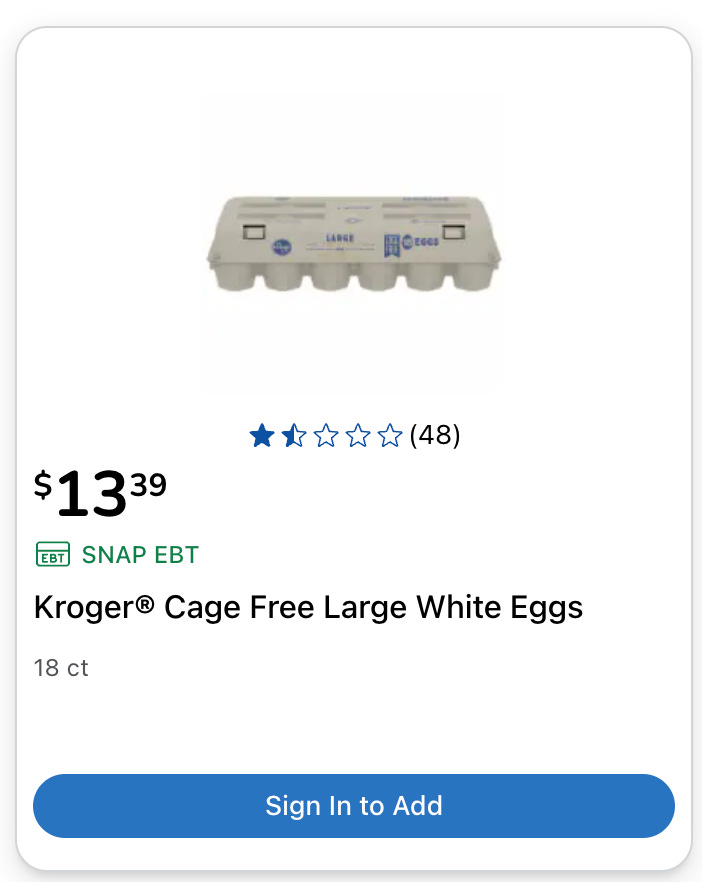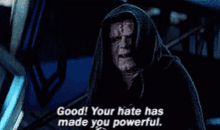Why Shit Sucks— and What We’re Going to Do About It
You’re not imagining it—shit's broken. But we deserve better, and together, we can fix it.
Grocery Prices Suck
Let’s start with some facts. At Ralph’s in Los Angeles, an 18-count carton of Kroger-brand eggs costs $13.39. No, not a luxury brand. Not eggs hand-laid by golden geese. Just regular, store-brand eggs. Thirteen dollars and thirty-nine cents.
You see that price and think: Why? Did the chickens unionize? Did the cost of feed suddenly triple overnight? Has the market started pricing in avian flu? What’s going on here?
It’s not just eggs. Rent, groceries, gas, healthcare—everything’s more expensive, and it feels like your paycheck just can’t keep up. It’s like you’re running a race against a moving finish line, and no matter how fast you go, you’re always behind.
Well here’s the good news: This isn’t your fault. The world didn’t just get this way. The system was built this way. And here’s the better news: It doesn’t have to stay this way.
What This Blog Is About
This blog isn’t just another place to scream into the void about why everything feels broken. We’re here to make sense of it—and figure out how to fix it together.
We’ll break down big, messy problems into simpler concepts that make sense to regular people, focusing on three key things:
The Shared Struggles we’re all dealing with—like rent, groceries, healthcare, etc.
The Root Causes behind those struggles—like concentrated power, corporate greed, and political corruption.
What Better Looks Like—real-world examples of systems that actually work.
And every post will leave you with concrete actions you can take. We’ll keep it simple:
If this issue is something you’re passionate about—a “main thing” for you—we’ll give you a step-by-step plan to take meaningful action.
If it’s not your main thing, we’ll offer an easy way to support those who are already leading the charge.
You don’t need to personally fix everything. Trying to fight every battle will only lead to burnout. Focus on what matters most to you and trust others to handle the rest. And if you’re not sure yet what your “main thing” is, stick with us—we’ll help you figure it out along the way.
Why This Blog Is Different
Before we go any further, let’s make one thing clear: this blog isn’t about partisanship.
It’s not about dunking on conservatives or liberals or blaming one side for everything. That kind of artificial division is exactly what the few at the top rely on to maintain the status quo. When we’re busy fighting each other, we’re not paying attention to how they’re stacking the deck against all of us.
Whether you lean left, right, or don’t care much for politics, we all feel the weight of rising costs, stagnant wages, and broken systems. These aren’t partisan problems—they’re human problems, so that’s where we’re focusing.
The distractions? They’re designed to keep us divided—blaming immigrants, DEI, “the woke agenda,” racist/sexist/ignorant bigots or whatever other convenient scapegoat is popular at the moment keeps us all looking sideways instead of upward. But the truth is simpler: the people profiting from all this division don’t care about your political beliefs. They care about hoarding power and profit, and they’re using both to keep things just the way they like them.
This blog is about breaking through the noise, finding common ground, and proving we don’t have to stay stuck in this mess.
What to Expect
Each post, we’ll explore an issue that affects regular people, like why eggs cost $13, why rent keeps climbing, or why that raise you fought for doesn’t go as far as it used to.
Here’s how we’ll tackle it:
Explain the problem. Clear, jargon-free breakdowns.
Follow the money. See who profits and how the system stays broken.
Point out the distractions. Explain the tactics they use to keep you distracted from the real problem.
Show what better looks like. Real-world systems that work differently—and better.
Empower you to act. Whether it’s a quick action you can take from your phone or a deeper way to get involved, we’ll give you steps that actually make sense—no guilt trips, no vague advice.
We think it bears repeating. You can’t fix everything yourself, and no one expects you to. But when we each focus on what we care about most and support others in their work, we can build real change—together.
So What Will These Action Items Look Like?
Here’s an example of what action steps can look like:
Let’s start small. First think about that $13 carton of eggs. Allow the anger to build and consume you…
If fixing grocery prices is your main thing:
Organize a Local Egg Buy to Support Small Farmers
Step 1: Find a local farm. Search for small-scale farms in your area through websites like LocalHarvest.org or by visiting your local farmers’ market.
Step 2: Reach out. Contact the farmer to ask about their egg availability, pricing, and whether they can handle bulk orders.
Step 3: Rally your community. Post in neighborhood groups, on social media, or at your workplace to see who’s interested in splitting a bulk egg order.
Step 4: Coordinate the buy. Collect orders and payments from neighbors (tools like Venmo or Google Forms make it easy) and place the bulk order with the farmer. Arrange a pickup or delivery day.
Step 5: Share the impact. Let your group know how their purchase supports local farmers—and that they just got fresh, affordable eggs without feeding the corporate machine.
Result: This simple action builds community, supports small-scale producers, and creates a model others can replicate.
If fixing grocery prices isn’t your main thing:
Support Food Advocacy with a Small Donation
Step 1: Pick a cause. Look up a nonprofit working to fight corporate monopolies or support fair food systems. Examples: Food & Water Watch, National Family Farm Coalition, or a local food bank.
Step 2: Set aside $5 (or what you can). Think of it like the cost of one coffee or a dozen eggs (before they got insanely expensive).
Step 3: Donate online. Use their website’s secure donation platform—it usually takes less than 2 minutes.
Step 4: Amplify your impact. Share the donation link with one friend or post it on social media. Even if one person joins you, you’ve doubled the support.
Result: Small actions like this might not feel huge, but they’re critical for funding the fight and signal that you’re part of a larger effort.
See that? Quick, easy(ish), optional, and totally doable!
Where Do We Go From Here?
Our shared struggles are universal. Rising costs and stagnant wages affect all of us, no matter where we live or who we vote for. These problems aren’t random—they’re the result of a system designed to concentrate power and wealth in the hands of a few, leaving the rest of us stressed, divided, and powerless.
But here’s the truth: the system only works because we let it. If we focus on our shared struggles instead of our differences, we can come together, push back, and start building a system that works for everyone.
So that’s what we’ll do—step by step, piece by piece, starting with something we all feel every day: the cost of living.
Next post, we’ll dig into your grocery bill: Why eggs are $13, why Kroger’s CEO made $15.7 million last year (and that’s after an 18% pay cut), and how we can push for lower prices without waiting on politicians to save us.
Ready to see what’s really going on—and how we can change it? Let’s get to work.




